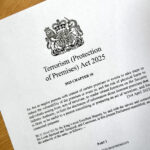Introduction
The world is changing, and so are the risks faced by public venues and businesses. With the Terrorism (Protection of Premises) Act 2025 — also known as Martyn’s Law — on the horizon, a new era of safety compliance is coming into force. This isn’t just another box-ticking exercise; it’s a wake-up call for every organisation responsible for the safety of staff, visitors, and the wider community.
So, what does this mean for your business? How do Lockdown and Invacuation Solution Systems fit into the picture? And how can you get ahead of the curve, ensuring both compliance and real-world protection? Let’s break it all down.
What is the Terrorism (Protection of Premises) Act 2025 (Martyn’s Law)?
Martyn’s Law is named in memory of Martyn Hett, a victim of the 2017 Manchester Arena attack. This legislation is designed to make UK venues and public spaces more resilient in the face of terrorist threats. Here’s what’s at its core:
- Mandatory terrorism risk assessments for qualifying premises.
- Implementation of proportionate security plans — not just paperwork, but real, actionable steps.
- Staff training to ensure everyone knows what to do in an emergency, including evacuation and lockdown procedures.
But who does this apply to? If you manage or own:
- Retail outlets
- Hospitality venues
- Entertainment spaces
- Schools and colleges
- Sports facilities
- Public buildings
…then Martyn’s Law is about to become part of your day-to-day operations.
Why Lockdown and Invacuation Solution Systems Matter
Let’s face it: in an emergency, every second counts. Lockdown and Invacuation Solution Systems are the backbone of a modern, effective emergency response. They’re not just about sounding alarms — they’re about giving you the power to act swiftly and decisively, protecting people when it matters most.
Key Functions of Lockdown and Invacuation Systems
- Instant, site-wide alerts: Dedicated lockdown buttons or triggers send clear, unmistakable signals — totally distinct from fire alarms — so there’s no confusion.
- Integrated controls: These systems can link up with your CCTV and access control, locking down specific zones or doors automatically.
- Mass notification: Whether it’s via SMS, email, or public address, everyone gets the message, fast.
- Zoned response: Not every area faces the same risk. Zoned lockdown lets you secure high-risk or public-facing spaces while keeping other areas open for evacuation or invacuation.
And, crucially, these systems are designed to align with British Standards like BS 5839, BS 7273, and BS 7858 — so you’re not just compliant, you’re covered with best practice.
What Does the New Law Mean for Different Property Types?
The Terrorism (Protection of Premises) Act 2025 isn’t a one-size-fits-all regulation. Here’s how it’s likely to affect different sectors:
1. Retail Outlets & Shopping Centres
- High footfall, multiple entry points: Lockdown systems must offer rapid, clear communication and the ability to secure multiple zones at once.
- Staff training: Employees need to recognise threats and respond without hesitation.
2. Hospitality Venues (Restaurants, Bars, Cafés)
- Open layouts: Systems should integrate with PA and lighting for instant alerts.
- Evacuation vs. lockdown: Staff must know when to shelter in place versus when to lead customers out.
3. Entertainment & Sports Venues
- Large crowds, complex layouts: Zoned lockdown and mass notification are crucial.
- Visitor management: Clear plans for both invacuation (moving people to safer internal zones) and evacuation.
4. Schools, Colleges, and Educational Campuses
- Duty of care: Systems need to be child-friendly and easy for staff to operate.
- Regular drills: Training and testing are a legal and moral necessity.
5. Public Buildings & Offices
- Mixed occupancy: Must accommodate both employees and visitors, often with varying levels of security clearance.
- Integration: Lockdown and invacuation systems should work with existing fire and security infrastructure.
How to Adhere to Martyn’s Law: A Step-by-Step Guide
Not sure where to start? Here’s a practical roadmap for compliance:
-
Conduct a Terrorism Risk Assessment
- Identify vulnerabilities in your premises.
- Assess the likelihood and potential impact of different threat scenarios.
-
Develop a Proportionate Security Plan
- Outline clear procedures for lockdown, invacuation, and evacuation.
- Assign roles and responsibilities.
-
Install Lockdown and Invacuation Solution Systems
- Choose systems that integrate with your existing infrastructure.
- Ensure they meet relevant British Standards.
-
Deliver Comprehensive Staff Training
- Run regular drills and refresher sessions.
- Make sure everyone knows their role in an emergency.
-
Maintain and Test Your Systems
- Schedule regular maintenance and system checks.
- Review and update your risk assessment and security plan annually (or after any incident).
Why Compliance is More Than Just a Legal Requirement
Sure, the law is the law. But at its heart, Martyn’s Law is about saving lives and giving peace of mind to everyone who walks through your doors. Compliance isn’t just about avoiding fines — it’s about doing the right thing for your staff, your customers, and your community.
How Wentworth Security & Fire Protection Can Help
Wentworth Security & Fire Protection Ltd is at the forefront of helping businesses prepare for Martyn’s Law. Here’s how they can support you at every stage:
- Consultation & Site Security Audits: In-depth assessments to pinpoint vulnerabilities and recommend tailored solutions.
- System Design & Integration: Bespoke lockdown and invacuation systems that work with your current fire and security setup.
- Installation: Professional, standards-compliant installation for maximum reliability.
- Staff Training: Practical, scenario-based training so your team is ready for anything.
- Ongoing Maintenance: Regular system checks and updates to keep you compliant and protected.
As a BAFE SP203-1 and SSAIB accredited provider, Wentworth delivers peace of mind with proven expertise and a commitment to quality.
Lockdown and Invacuation Solution Systems: Your FAQs Answered
What’s the difference between lockdown and invacuation?
Lockdown keeps people in their current location, securing doors and restricting movement. Invacuation moves people to a safer, more secure area within the building.
Does Martyn’s Law apply to my business?
If your premises are open to the public and meet certain size or capacity criteria, yes — you’ll need to comply.
How quickly can a lockdown system be installed?
It depends on your building’s layout and existing infrastructure, but Wentworth can provide a clear timeline after an initial assessment.
Can lockdown systems be integrated with fire alarms and CCTV?
Absolutely. Integration is key for a seamless emergency response.
What standards should my system meet?
Look for compliance with BS 5839, BS 7273, BS 7858, and relevant fire and security regulations.
Do staff need special training?
Yes, effective training is required by law and essential for a real-world response.
Conclusion
Lockdown and Invacuation Solution Systems aren’t just a compliance checkbox — they’re a lifeline. With Martyn’s Law coming into force, now’s the time to act. Whether you manage a busy shopping centre, a school, or a hospitality venue, the right systems and training can make all the difference.
Wentworth Security & Fire Protection is ready to guide you through every step, from risk assessment to ongoing support. Don’t wait for the law to catch up — get ahead, protect your people, and build a safer future for your business and community.
Ready to discuss your needs? Reach out to Wentworth Security & Fire Protection Ltd today for a consultation or visit www.wentsec.co.uk.



